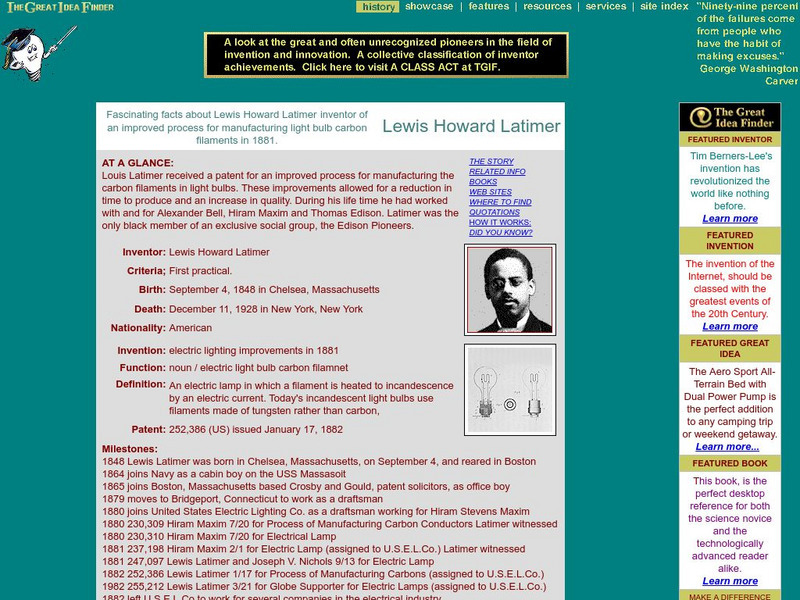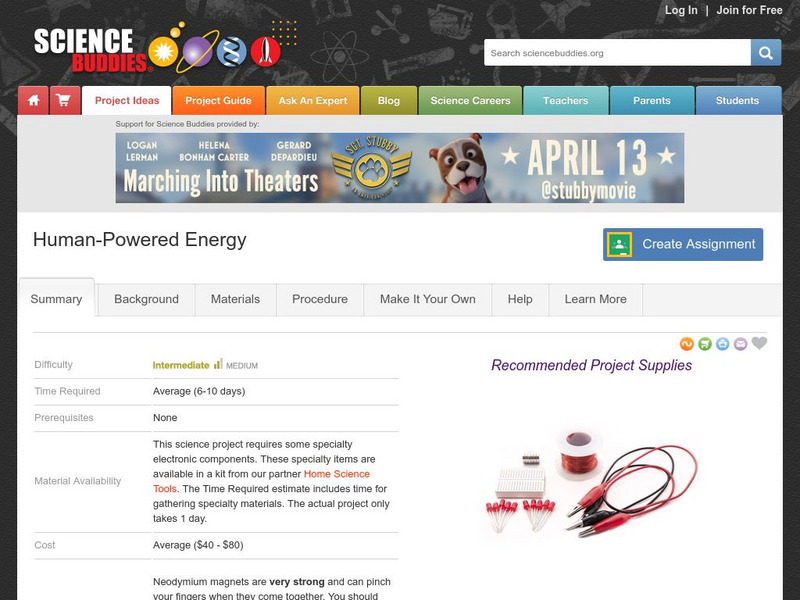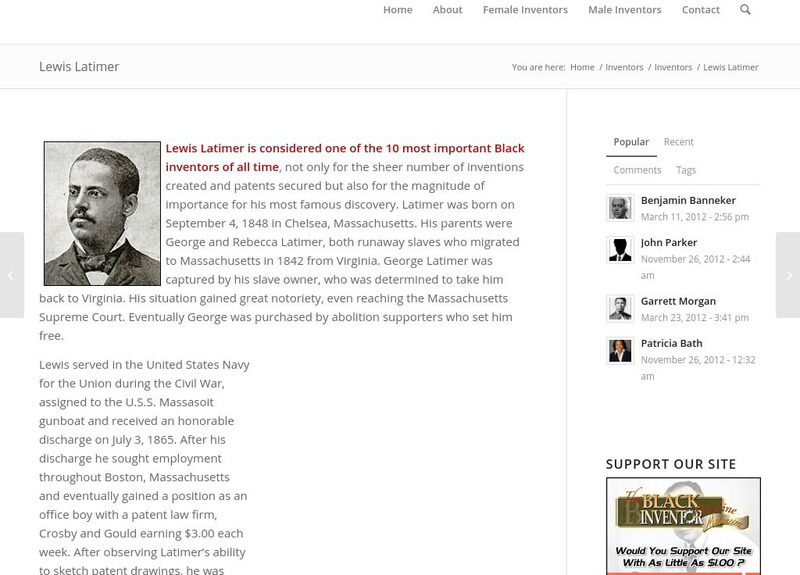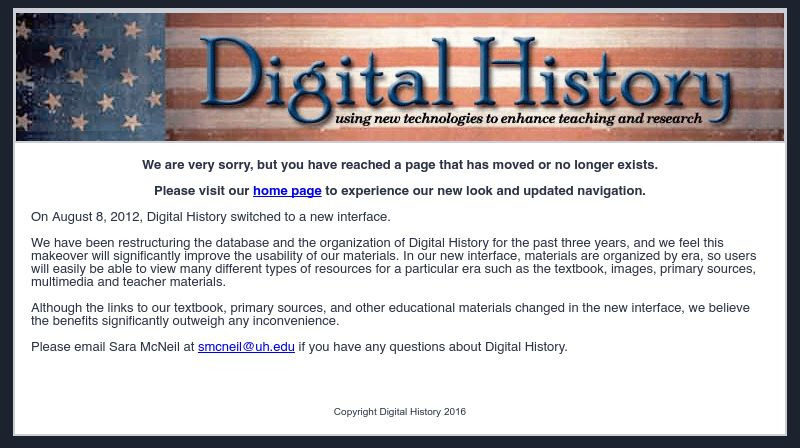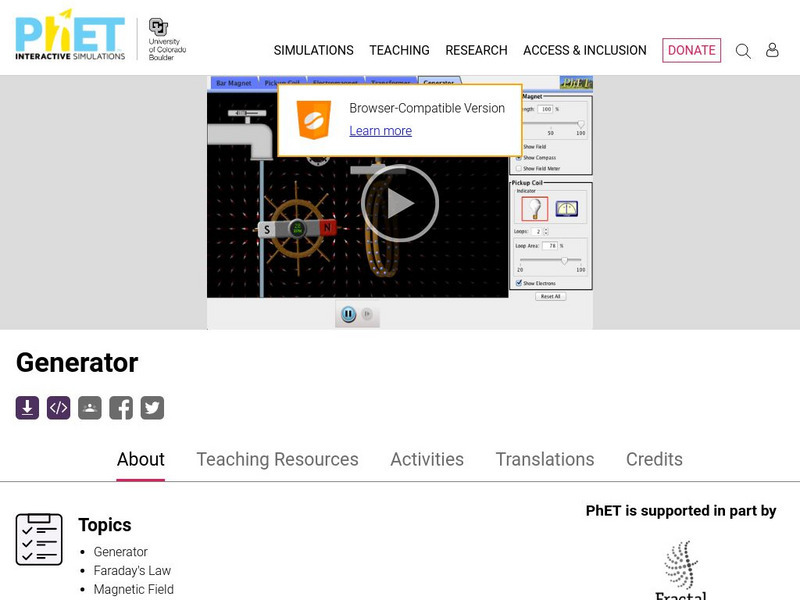Hi, what do you want to do?
Houghton Mifflin Harcourt
Harcourt: Biographies: Thomas Edison
A good description of the inventions and life of this bright and ambitious man. As inventor of the light bulb, phonograph, movie camera and many others, Edison lived a very inspiring life. In Spanish.
Great Idea Finder
Great Idea Finder: Lewis Howard Latimer
An extensive biography of the life of African-American inventor, Lewis Latimer. Find out about his primary claim to fame in the development of an incandescent light bulb, but be sure to read about his many patents, and his importance to...
TeachEngineering
Teach Engineering: Completing the Circuit
In the everyday electrical devices we use - calculators, remote controls and cell phones - a voltage source such as a battery is required to close the circuit and operate the device. In this hands-on activity, students use a battery,...
University of Colorado
University of Colorado: Ph Et Interactive Simulations: Circuit Construction Kit (Dc Only)
An electronics kit in your computer! Build circuits with resistors, light bulbs, batteries, and switches. Take measurements with the realistic ammeter and voltmeter. View the circuit as a schematic diagram, or switch to a life-like view....
Curated OER
National Park Service: Thomas Edison National Historical Park: Thomas Edison
This site includes information about Thomas Edison's inventions and his home and family life. Find a lengthy biography and several sounds from Edison's original phonograph.
Library of Congress
Loc: America's Story: Thomas Alva Edison
A variety of images, photographs, and information on the life of Thomas Alva Edison (1847-1931) can be found in the site by the Library of Congress. Information can be found here regarding his invention and influence on American society....
Florida State University
Florida State University: Magnet Lab: Electric Meter 1872
The invention of the light bulb quickly created the need to track people's electricity usage. In 1872, Samuel Gardiner built the first simple power meter: a lamp with an attached clock that recorded the time the light was on.
TeachEngineering
Teach Engineering: Saltwater Circuit
Students build a saltwater circuit, which is an electrical circuit that uses saltwater as part of the circuit. Students investigate the conductivity of saltwater, and develop an understanding of how the amount of salt in a solution...
Science Buddies
Science Buddies: Shaking Up Some Energy
Shake N' Light flashlights have been advertised on televisions across the nation in the recent year. But many do not understand just how they get energy to light up the bulb without using batteries. Do this experiment to make your own...
Other
Earliest Voices: Thomas Edison
This resource offers historic voice recordings of Thomas Edison. There is a recording of animal sounds, and a speech given at an electrical exhibition in 1908. A biography and downloadable images of him are also included.
Other
Black Inventor Online Museum: Lewis Latimer
The biography of the fascinating African-American inventor, Lewis Latimer. In addition to finding out about his development of the carbon filament for the incandescent lamp, you can read about his expertise in patent law, his association...
Digital Public Library of America
Dpla: Electrifying America
This primary source set explores the development, commercialization, and impact of electricity.
Digital History
Digital History: The Wizard of Menlo Park
This resource provides information about the famous American inventor, Thomas Edison. Find out about his childhood, some of his famous inventions, and even some of his mistakes.
PBS
Pbs: Who Made America?: Innovators: Thomas Edison
The "Wizard of Menlo Park" brought the world electric light, recorded music, and the movies, among other things, and turned innovation into a science by inventing the research laboratory.
Smithsonian Institution
Lemelson Center: Invention Features: Lewis Latimer
Smithsonian site features the life and many accomplishments of Lewis Latimer, the famous African-American inventor.
Science Struck
Science Struck: Facts About Thomas Edison
Read about the life of Thomas Edison and his many inventions.
Massachusetts Institute of Technology
Mit: Invention of the Week: Thomas Alva Edison
As the inventor of the lightbulb, phonograph, and the printing telegraph, Thomas Alva Edison (1847-1931), improved the daily lives of everyday people.
University of Colorado
University of Colorado: Ph Et Interactive Simulations: Generator
Generate electricity with a bar magnet! Discover the physics behind the phenomena by exploring magnets and how you can use them to make a bulb light. Java required.
PBS
American Experience: Technology Timeline: 1752 1990
Short descriptions of important technological innovations produced in America and the date of their introduction.
Enchanted Learning
Enchanted Learning: Inventors & Inventions 1801 1850
This site from Enchanted Learning presents several brief overviews of major early nineteenth century inventors and their inventions. The information is accessible by clicking on the corresponding link.
National High Magnetic Field Laboratory
Magnet Academy: Fluorescent Lamp 1934
Compared to incandescent lamps, fluorescent lamps last longer, require less energy and produce less heat, advantages resulting from the different way in which they generate light.
Science Struck
Science Struck: Lemon Battery Experiment
In this step-by-step experiment, you will learn how to make a battery using four lemons and use it to light an LED bulb.
Famous Scientists
Famous Scientists: Thomas Alva Edison
Meet the inventor of the phonograph, the motion picture camera, and the long-lasting, practical electric light bulb, Thomas Edison.
Curated OER
Educational Technology Clearinghouse: Clip Art Etc: Thomas Alva Edison
Thomas Alva Edison (February 11, 1847 - October 18, 1931) was an American inventor and businessman who developed many devices that greatly influenced life around the world, including the phonograph and the long-lasting, practical...






